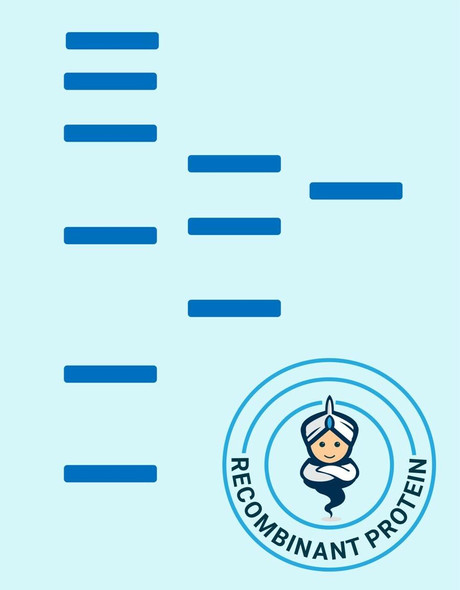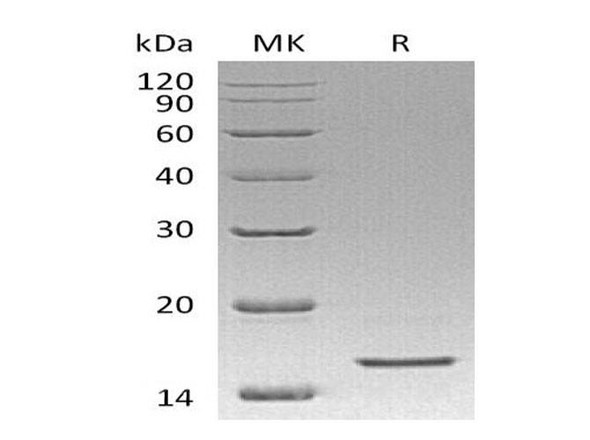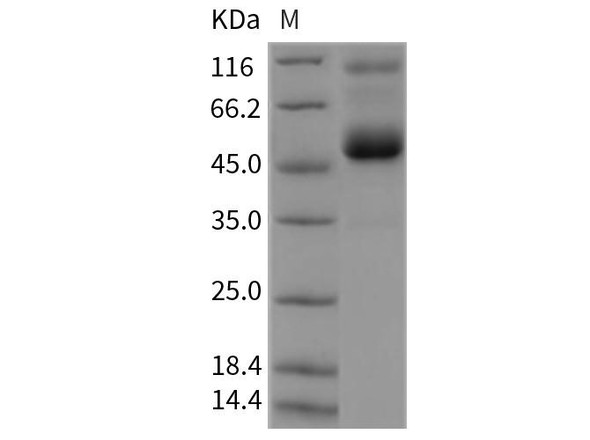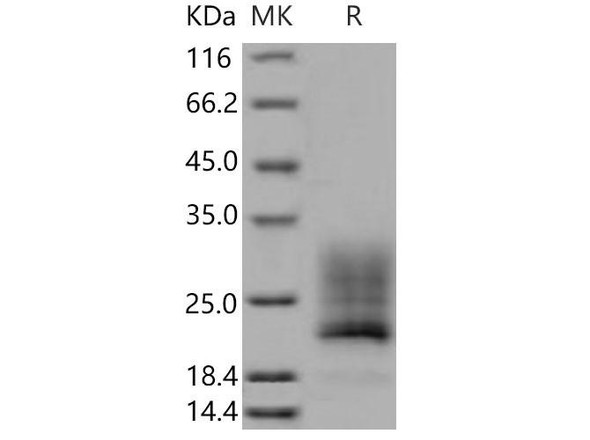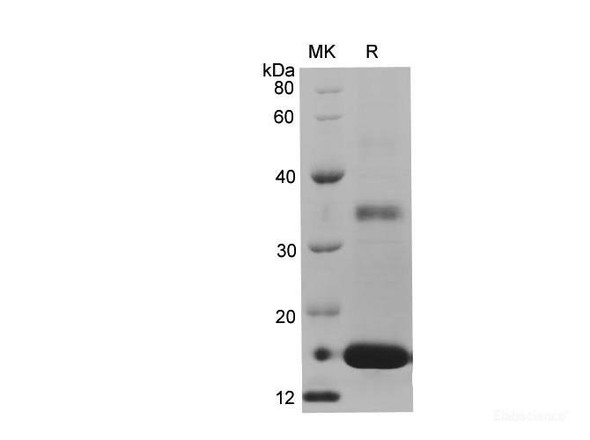Human REG4 Recombinant Protein (RPPB4438)
- SKU:
- RPPB4438
- Product Type:
- Recombinant Protein
- Species:
- Human
- Uniprot:
- Q9BYZ8
Description
| Product Name: | Human REG4 Recombinant Protein |
| Product Code: | RPPB4438 |
| Size: | 10µg |
| Species: | Human |
| Target: | REG4 |
| Synonyms: | Regenerating islet-derived protein 4, Reg IV, REG-like protein, Gastrointestinal secretory protein, REG4, GISP, RELP. |
| Source: | Escherichia Coli |
| Physical Appearance: | Filtered White lyophilized (freeze-dried) powder. |
| Formulation: | Filtered (0.4�m) and lyophilized from 0.5 mg/ml in 20mM Tris, pH 8.0. |
| Solubility: | Add deionized water to a working concentration approximately 0.5 mg/ml and let the lyophilized pellet dissolve completely. Product is not sterile! Please filter the product by appropriate sterile filter before using it in the cell culture. |
| Stability: | Store lyophilized protein at -20°C. Aliquot the product after reconstitution to avoid repeated freezing/thawing cycles. Reconstituted protein can be stored at 4°C for a limited period of time; it does not show any change after two weeks at 4°C. |
| Purity: | Greater than 95% as determined by SDS-PAGE. |
| Amino Acid Sequence: | MKHHHHHHAS HMDIIMRPSC APGWFYHKSN CYGYFRKLRN WSDAELECQS YGNGAHLASI LSLKEASTIA EYISGYQRSQ PIWIGLHDPQ KRQQWQWIDG AMYLYRSWSG KSMGGNKHCA EMSSNNNFLT WSSNECNKRQ HFLCKYRP |
REG protein was shown to be stimulated during the regeneration of pancreatic islets. Since then, many Reg-related proteins have been identified in humans and other animals. In human, the four REG family genes, i.e., REG 1 alpha, REG 1 beta, REG-related sequence (RS) and HIP/PAP, have so far been isolated. These Reg-related proteins are classified into four subfamilies according to their amino-acid sequences, but they share a similar structure and physiological function. Reg protein is a growth factor for pancreatic beta cells and also suggests that the administration of Reg protein could be used as another therapeutic approach for diabetes mellitus. Human REG cDNA which encodes a 166-amino acid protein with a 22-amino acid signal peptide. The amino acid sequence of human REG protein has 68% homology to that of rat Reg protein.Reg I was found to be expressed mainly in pancreatic beta and acinoductular cells as well as gastric fundic enterochromaffin-like (ECL) cells. Reg I production in ECL cells is stimulated by gastrin, as well as by the proinflammatory cytokine, cytokine-induced neutrophil chemoattractant (CINC)-2Beta. In patients with chronic hypergastrinemia, Reg production is stimulated, with the increased proliferation of gastric mucosal cells. Patients with Helicobacter pylori infection also showed increased Reg production in the gastric mucosa, partly via increased plasma gastrin concentration and partly via increased proinflammatory cytokine production. The serum concentration of the reg-protein was significantly higher in patients with various pancreatic diseases than in normal controls, and was also significantly higher in patients with acute pancreatitis or chronic relapsing pancreatitis than in patients with chronic pancreatitis. Furthermore, the serum PSP/reg-protein concentration was also significantly increased in liver cirrhosis, choledocholithiasis, and various cancers of the digestive system.
The Recombinant Human REG-4 is manufactured with N-terminal fusion of His Tag. The Recombinant Human REG-IV His-Tagged Fusion Protein is 17.4 kDa protein containing 136 amino acid residues of the Human REG 4 and 12 additional amino acid residues � His Tag (underlined).
| UniProt Protein Function: | REG4: Calcium-independent lectin displaying mannose-binding specificity and able to maintain carbohydrate recognition activity in an acidic environment. May be involved in inflammatory and metaplastic responses of the gastrointestinal epithelium. 2 isoforms of the human protein are produced by alternative splicing. |
| UniProt Protein Details: | Protein type:Secreted; Secreted, signal peptide Chromosomal Location of Human Ortholog: 1p13.1-p12 Cellular Component: cytoplasm; extracellular region Molecular Function:heparin binding; calcium ion binding |
| UniProt Code: | Q9BYZ8 |
| NCBI GenInfo Identifier: | 68565834 |
| NCBI Gene ID: | 83998 |
| NCBI Accession: | Q9BYZ8.1 |
| UniProt Secondary Accession: | Q9BYZ8,Q8NER6, Q8NER7, |
| UniProt Related Accession: | Q9BYZ8 |
| Molecular Weight: | 14,993 Da |
| NCBI Full Name: | Regenerating islet-derived protein 4 |
| NCBI Synonym Full Names: | regenerating islet-derived family, member 4 |
| NCBI Official Symbol: | REG4�� |
| NCBI Official Synonym Symbols: | GISP; RELP; REG-IV�� |
| NCBI Protein Information: | regenerating islet-derived protein 4; REG-4; reg IV; REG-like protein; regenerating gene type IV; gastrointestinal secretory protein; regenerating islet-derived protein IV |
| UniProt Protein Name: | Regenerating islet-derived protein 4 |
| UniProt Synonym Protein Names: | Gastrointestinal secretory protein; REG-like protein; Regenerating islet-derived protein IV; Reg IV |
| Protein Family: | Regenerating islet-derived protein |
| UniProt Gene Name: | REG4�� |
| UniProt Entry Name: | REG4_HUMAN |


